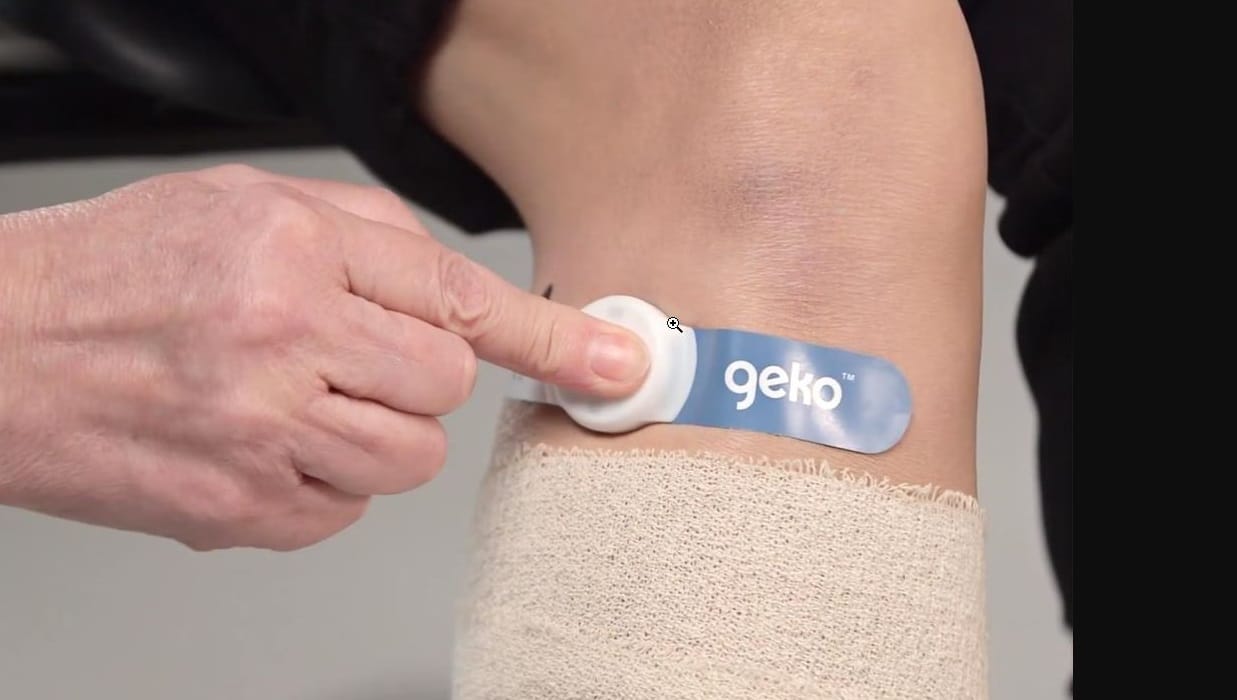Developed by Sky Medical Technology, geko™ is a non-invasive wearable device clinically proven to increase blood flow in the deep veins of the calf through neuromuscular electrostimulation. Using the exclusive OnPulse™ technology, it can prevent venous thrombosis and treat edemas.
Traditional neuro-muscle stimulators employ electrical stimulation directly on the muscle bulk to force contraction, often with large stimulus amplitudes that can bring discomfort to the patient. The proprietary technology OnPulse™ present in geko™, however, employs low-frequency nerve stimulation delivering current via non-invasive skin surface electrodes placed on the leg externally.
Shaping itself easily and comfortably to the outer/lateral aspect of the knee, the geko™ device stimulates the motor neurons within the common peroneal nerve, a bundle formed by the fibular nerve, the external popliteal nerve and the lateral popliteal nerve.
An Extra Flow Equivalent to 60% of That Derived From Walking
It also uses a conductive hydrogel to facilitate adhesion and the movement of the electric signals from the electrode into the skin, causing the muscle fibers to contract. In this way, the device simultaneously activates the tibialis, peroneus longus and lateral gastrocnemius muscles. This results in increased activation of the calf and foot muscles, promoting blood flow and the efficient evacuation of blood from the deep veins.
This extra flow is equivalent to 60% of that derived from walking, but obviously without any increase in heart rate and blood pressure. Also, the muscle contractions are isometric, which means muscle contraction is fairly static without any visible movement in the joints. And muscle length remains relatively constant when tension is produced.
Two Versions of the Device
The device comes in slightly different versions. The geko™ (T) is used to prevent blood clots in acute stroke patients and manage post-operative and trauma-based edema in orthopedics. The geko™ (W) variant has been developed to accelerate the rate of healing of chronic wounds (leg ulcers). The geko™ (T) device needs to be worn on both legs for 24 hours per day, while the geko™ (W) requires two 12-hour treatments, each on separate days.
The geko™ device is about the size of a wristwatch and weighs only 10 grams; it is self-adhesive, disposable, self-powered and poses no risk of shock thanks to its fully insulated protective molding. There are also no potential tripping hazards as there are no external wires.


The software of the geko™ device is controlled with plus and minus buttons, offering 11 different stimulation settings, promoting painless 1Hz frequency contractions. The patient will be aware of muscle contraction, but that sensation diminishes after a few minutes, to the point where the user can carry out routine activities (including sleep), with the exception of bathing, as the device should not be exposed to water.
Patients with recently diagnosed or suspected deep vein thrombosis, heart conditions, epilepsy, pregnancy and those who are breastfeeding or who have recently undergone surgery should seek additional medical advice before using geko™. People allergic to acrylic acid should avoid the product as the conductive hydrogel used contains acrylic polymers.
History and Challenges
The first market trial occurred in 2013 at the Royal Stoke University Hospital. Bernard Ross, CEO and founder of Sky Medical Technology, explained:
“Our main motivation when creating geko™ was to serve the needs of immobile acute stroke patients.
The CLOTS-3 study—a multicenter parallel group randomized trial assessing intermittent pneumatic compression (IPC) in immobile patients—indicates that around 30% of acute stroke patients cannot tolerate standard of care venous thromboembolism (VTE) prevention, such as drug prophylaxis with low molecular weight heparin or IPC. And that leaves a large portion of them at high risk of developing life-threatening blood clots.”

In the case of patients who could not be prescribed IPC, these trials showed that VTEs or pulmonary embolisms (PEs) did not occur when they were treated with the geko™ device. In its guidance reference MTG19, the National Institute for Health and Care Excellence (NICE) also recommends the use of geko™ when other prophylactic methods cannot be used.
Bernard Ross added:
“Before being adopted, medical technology devices are increasingly required to demonstrate proven positive outcomes such as speeding up recovery times, reducing treatment costs or making treatment better. In the last decade, they have been subject to similar stringent regulation as new drugs, and innovation cannot be implemented into healthcare systems without real-world clinical and economic evidence of success.
Only then will a device have the potential to achieve regulatory approval—which is another hurdle in itself. We had a particularly unique challenge with the geko™ device as it is considered a ‘platform technology’, meaning it serves more than one medical application. This required each application to be treated as entirely new to gain regulatory approval and adoption.”
And it is likely that more possible uses for geko™ will follow. Any condition which requires enhanced blood flow to improve clinical outcomes could, in theory, benefit from it.
In addition to tendon and ligament injuries for which the device is already being used, an interesting example is the outcome of a landmark multi-center randomized self-controlled trial (RCT) that compared the results of clinical care with and without the geko™ device in patients with hard-to-heal venous leg ulcers (VLUs). The research revealed that with the device, the rate of wound healing in patients was double compared to those who received only standard care.
“With VLUs affecting one in 500 adults in the United Kingdom and costing the National Health Service (NHS) around $2.5 billion annually, the results of this study offer new hope to patients and a new solution to help reduce the financial burden on the NHS.”










